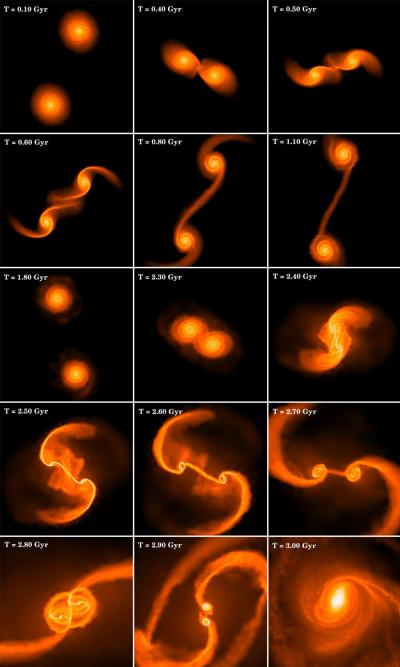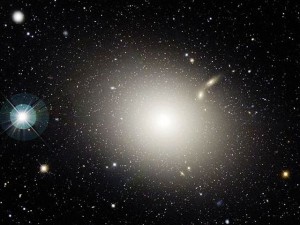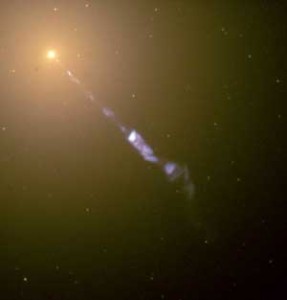 This is how astronomers think giant galaxies form super-massive black holes (the adjectives are the astronomers’). Way back at the beginning, maybe a billion years after the birth of a 14 billion year old universe, enormous galaxies a hundred times bigger than the Milky Way were born, pulling themselves together out of clouds of stars and hydrogen gas into spirals. Neighboring spirals swirled into each other, swooped back out leaving long plumes called tidal tails, fell back together again, over and over, until they couldn’t pull apart any more and gradually merged into a single galaxy. During the merger, the bright gas was pulled by gravity toward the center into a more brilliant central disk, and inside the disk, finally, no one knows how, gravity won entirely and the gas collapsed into a single point so massive and dense that light itself was caught in a black hole. Or at least, that’s the story. It’s probably true, though observations of the young universe are hard to make. So to help observers know what to look for, theorists make computer simulations. This is a simulation.
This is how astronomers think giant galaxies form super-massive black holes (the adjectives are the astronomers’). Way back at the beginning, maybe a billion years after the birth of a 14 billion year old universe, enormous galaxies a hundred times bigger than the Milky Way were born, pulling themselves together out of clouds of stars and hydrogen gas into spirals. Neighboring spirals swirled into each other, swooped back out leaving long plumes called tidal tails, fell back together again, over and over, until they couldn’t pull apart any more and gradually merged into a single galaxy. During the merger, the bright gas was pulled by gravity toward the center into a more brilliant central disk, and inside the disk, finally, no one knows how, gravity won entirely and the gas collapsed into a single point so massive and dense that light itself was caught in a black hole. Or at least, that’s the story. It’s probably true, though observations of the young universe are hard to make. So to help observers know what to look for, theorists make computer simulations. This is a simulation.

To see a video of the simulation, click here; it’s worth it. The simulation doesn’t show how the merger ends: the two spirals have merged to form a big elliptical galaxy. Those big ellipticals from the universe’s hot youth are still around and the astronomers who did this simulation think that our neighbor, M87, might be one of them. M87 has a black hole at its center with the mass of a couple billion suns. Gas falling into the black hole gets caught up in M87 magnetic fields and shot back out in a jet about 5,000 light years long.

M87 is not a simulation, it’s real. So is that jet. I just don’t know how I can keep worrying about book sales and limp hair in the face of all this spectacular fury and glory.
Credits:
Simulation: Ohio State University
M87: Canada-France-Hawaii Telescope